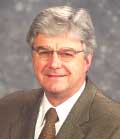
SPRING 2004
This issue marks the beginning of the second year of Engineering Enterprise. Themes to be addressed this year include natural systems, health systems, knowledge mining, and supply chain management. And, of course, there will be lots of news regarding the activities and accomplishments of our students, alumni, and faculty.
The field of "natural systems" considers what should be learned from nature that can guide the design and deployment of engineered systems. In the interview in this issue with alum Ray Anderson, CEO of Interface, Inc., you will learn how the new carpet in my office at Georgia Tech was designed on the basis of how nature designs floor covering in a forest. When you are on campus, stop by the ISyE Chair's Suite to see the best-selling Entropy floor covering that resulted from Interface's trips to the forest.
This issue also provides a fascinating glimpse into studies of ants and bees by John Bartholdi and Craig Tovey. Ants and bees can provide great insights into how best to handle logistics and supply chain management.
Natural systems can provide important insights into sustainable design and development. This is of broad interest at Georgia Tech, as evidenced by the many activities of the Institute of Sustainable Technology and Development (ISTD), led by Bert Bras of the Woodruff School of Mechanical Engineering. This issue highlights the roots, formation, and accomplishments of ISTD.
Why is all this of interest? Engineers are great at designing solutions to problems in both private and public sectors. However, these solutions often consume considerable non-renewable resources and produce significant wastes. Nature is often better at evolving solutions that consume renewable resources (e.g., sunlight) and produce biodegradable by-products (e.g., cellulose). Efficiency is a hallmark of natural solutions.
As an example of such efficiency, consider the carpet in my office, designed by studying the forest. Like nature, the pattern of the carpet does not repeat. Any panel can go any place. Any piece cut from one panel to fit an edge can be deployed to another place to fill an edge. Thus, waste is minimized. Best of all, the name is Entropy. Can you think of a better name for the floor covering in a faculty member's office?
 the CHAIR
the CHAIR
![]()
Natural Systems
![]()
![]()
by William B. Rouse
![]()
William B. Rouse is the H. Milton and Carolyn J. Stewart Chair and Professor of the School of Industrial and Systems Engineering at the Georgia Institute of Technology.
![]()
![]()
![]()
• Spring 2004 Engineering Enterprise Table of Contents
• Engineering Enterprise Home Page
![]()
![]()
![]()
Web Site © Copyright 2020 by Lionheart Publishing, Inc. and ISyE, Georgia Institute of Technology. All rights reserved. No portion of this publication may be reproduced in any form without the written permission of the publisher.
![]()
![]()
Lionheart Publishing, Inc.
34 Hillside Ave
Phone: +44 23 8110 3411 |
E-mail:
Web: www.lionheartpub.com
![]()
ISyE / Georgia Institute of Technology
Atlanta, GA 30332-0205
|
Web: www.isye.gatech.edu